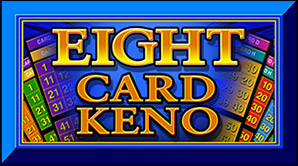Calculating progressive strategy changes
-
Minn. Fatz
- VP Veteran
- Posts: 524
- Joined: Mon May 07, 2007 12:22 am
Calculating progressive strategy changes
(or, Math Does Not Suck )
When a progressive payoff is high enough, 3-card (and possibly 2-card) RF draws that usually have less expected value (EV) than other options may become "worth it." The usual method for determining when this is the case involves incrementing RF payoffs in training programs and recalculating over multiple hand analyses by trial and error. However, a relatively simple mathematical formula enables one to calculate the value of the progressive payoff that triggers these strategy changes using only the EVs for the underlying game.
We want to solve for:
R >= (V1 - V2) / (p2 - p1)
where:R is the value of the progressive jackpot
V1 is the EV for the "normal" play, excluding any value from a possible RF
V2 is the EV for the RF draw, also excluding any value from a possible RF
(Note that all three variables above are expressed in coins per coin in.)
p1 is the probability of making an RF with the "normal" play
p2 is the probability of making an RF from the alternative RF draw
When the inequality holds for R, we should draw to the RF in preference to the "normal" play.
To find V1 and V2, simply use any training program’s hand analyzer, inputting any initial hand that matches the kind of hand under consideration. The value of V1 will usually, if not always, be the EV for the best play (see below). To find V2, subtract the product of p2 and the normal RF payoff (usually 800 per coin in) from the total EV of the RF draw.
Note that p2 will always equal 1/combin(47,n) where n is the number of cards to fill the RF draw, so the product referenced above will (usually) be 800/combin(47,n). Also, when the "normal" play is to hold a pair or another combination that cannot make an RF, as is nearly always the case, p1= 0.
Therefore we can restate the formula above as:
R >= (V1 - V2) * combin(47,n)
Note that the value of R increases as either V1 or n increase or as V2 decreases, which is as expected. given a more valuable "normal" play, an RF draw that’s harder to fill, or a lower ev from an RF draw excluding the RF, we need a higher progressive payoff to justify a strategy change.
(Also note that R is expressed in terms of payoff per coin in, so multiply that value by 5 to get the needed figure for the total progressive jackpot.)
Example calculation: AsQsJsAh3d in 6/5 JB
V1 = 1.8825; this is the EV of drawing to the pair of Aces
V2 = ( 1.6894 - 800/combin(47,2) ) = (1.6894 - 800/1081) = (1.6894 - 0.7401) = 0.9493
(V1 - V2) = 0.9332
R >= 0.9332 * 1081 = 1009 (rounding up)
5R = 5045
In order for the RF draw to have greater EV than drawing to the pair of Aces for the selected hand in 6/5 JB, the progressive jackpot for the RF should total 5045 coins or more.
Derivation of the formula: by definition, the ev of the "normal" play is (V1 + Rp1) and of the alternative RF draw is (V2 + Rp2). then:
(V2 + Rp2) >= (V1 + Rp1) -> R*(p2 - p1) >= (V1 - V2) -> R >= (V1 - V2) / (p2 -p1)
When a progressive payoff is high enough, 3-card (and possibly 2-card) RF draws that usually have less expected value (EV) than other options may become "worth it." The usual method for determining when this is the case involves incrementing RF payoffs in training programs and recalculating over multiple hand analyses by trial and error. However, a relatively simple mathematical formula enables one to calculate the value of the progressive payoff that triggers these strategy changes using only the EVs for the underlying game.
We want to solve for:
R >= (V1 - V2) / (p2 - p1)
where:R is the value of the progressive jackpot
V1 is the EV for the "normal" play, excluding any value from a possible RF
V2 is the EV for the RF draw, also excluding any value from a possible RF
(Note that all three variables above are expressed in coins per coin in.)
p1 is the probability of making an RF with the "normal" play
p2 is the probability of making an RF from the alternative RF draw
When the inequality holds for R, we should draw to the RF in preference to the "normal" play.
To find V1 and V2, simply use any training program’s hand analyzer, inputting any initial hand that matches the kind of hand under consideration. The value of V1 will usually, if not always, be the EV for the best play (see below). To find V2, subtract the product of p2 and the normal RF payoff (usually 800 per coin in) from the total EV of the RF draw.
Note that p2 will always equal 1/combin(47,n) where n is the number of cards to fill the RF draw, so the product referenced above will (usually) be 800/combin(47,n). Also, when the "normal" play is to hold a pair or another combination that cannot make an RF, as is nearly always the case, p1= 0.
Therefore we can restate the formula above as:
R >= (V1 - V2) * combin(47,n)
Note that the value of R increases as either V1 or n increase or as V2 decreases, which is as expected. given a more valuable "normal" play, an RF draw that’s harder to fill, or a lower ev from an RF draw excluding the RF, we need a higher progressive payoff to justify a strategy change.
(Also note that R is expressed in terms of payoff per coin in, so multiply that value by 5 to get the needed figure for the total progressive jackpot.)
Example calculation: AsQsJsAh3d in 6/5 JB
V1 = 1.8825; this is the EV of drawing to the pair of Aces
V2 = ( 1.6894 - 800/combin(47,2) ) = (1.6894 - 800/1081) = (1.6894 - 0.7401) = 0.9493
(V1 - V2) = 0.9332
R >= 0.9332 * 1081 = 1009 (rounding up)
5R = 5045
In order for the RF draw to have greater EV than drawing to the pair of Aces for the selected hand in 6/5 JB, the progressive jackpot for the RF should total 5045 coins or more.
Derivation of the formula: by definition, the ev of the "normal" play is (V1 + Rp1) and of the alternative RF draw is (V2 + Rp2). then:
(V2 + Rp2) >= (V1 + Rp1) -> R*(p2 - p1) >= (V1 - V2) -> R >= (V1 - V2) / (p2 -p1)
-
shadowman
- Video Poker Master
- Posts: 3587
- Joined: Mon Oct 23, 2006 5:42 pm
Translating a little: Since most cases will NOT have a RF draw in the highest EV hand, this is a simpler way to look at it:
Goal_ER*Num_draws - Current_ER*Num_draws = required increase in RF payout. Or, ...
Num_draws*(Goal_ER - Current_ER) + 4000 = New RF value in credits.
Goal_ER (highest ER) and Current_ER (of RF hold) are output from the software hand analyzers and Num_draws is the number of possible draws for the RF which is normally displayed on the line with the Current_EV.
thought I'd add an example: In the earlier NSUD example (AKQJ2):
Goal_ER = 125 (ER of wild RF)
Current_ER = 95.9574 (ER of AKQJ)
Num_draws = 47 (number of possible draws of one card)
1081*(125-95.9574)+4000 = 5365
Goal_ER*Num_draws - Current_ER*Num_draws = required increase in RF payout. Or, ...
Num_draws*(Goal_ER - Current_ER) + 4000 = New RF value in credits.
Goal_ER (highest ER) and Current_ER (of RF hold) are output from the software hand analyzers and Num_draws is the number of possible draws for the RF which is normally displayed on the line with the Current_EV.
thought I'd add an example: In the earlier NSUD example (AKQJ2):
Goal_ER = 125 (ER of wild RF)
Current_ER = 95.9574 (ER of AKQJ)
Num_draws = 47 (number of possible draws of one card)
1081*(125-95.9574)+4000 = 5365

























































